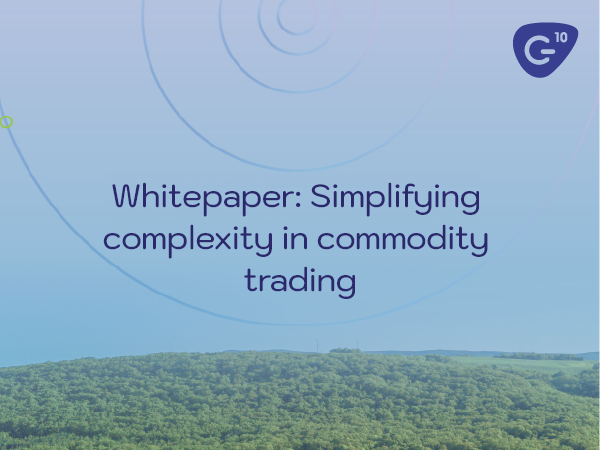Supply chain traceability allows organisations to trace products or their constituent parts back along the value chain, with the goal of complete visibility to the farm, mine or original production site. It is important for sustainability initiatives, which we are focusing on today, but also for identifying and mitigating issues at different stages of supply chains. And this means that it is also a vital tool in supply chain optimisation, helping organisations understand their optimal suppliers, transporters, and partners.
Traceability looks different for every commodity, with different problem areas and consumer focal points, but what they all have in common is that traceability is a pressing concern that is not going away.
Sustainability has been a consideration in commodities for at least the last 20 years, with several consumer-driven trends over this time. Focal points include the introduction of organic certifications, deforestation concerns (particularly in palm oil), modern slavery and child labour, textile sustainability, food waste, and now a nascent but growing focus on carbon dioxide emissions across the supply chain. And it is only by improving traceability that organisations can monitor and mitigate these sustainability issues.
And even when commodity ESG initiatives are not reaching the public consciousness, there are still many projects where commodity producers and traders are coming together to improve supply chain visibility and enable corporations to meet their ESG targets.
What’s driving traceability in commodity supply chains?
1. Legislation
Legislation may not be the only reason for you and organisations in your supply chain to be improving traceability, but it does provide a common baseline for the minimum standard across each industry.
Legislation varies by geography and commodity, so each organisation may be expected to comply with several different regimes, and this legislation is also ever-changing and growing more stringent.
For example, in the US the FDA introduced basic food traceability legislation in 2002 and 2011, but the latest 2020 Proposed Rule for Food Traceability specifies 16 higher risk foods including nut butters and the Key Data Elements that need to be recorded at various stages of the supply chain.
These stages, or Critical Tracking Events include growing, receiving, transforming, creating, and shipping. And in our world of connected, interdependent supply chains, soft commodities that are not covered under this legislation could well be operating with partners who are complying for other products and expect a similar level of record-keeping.
Elsewhere, a new AEGC law in France requires environmental labelling for sectors including electrical equipment (including showing their scrap metal usage) and textiles. This could be followed by EU-wide standardisation of environmental claims in textiles, which would require adequate traceability, by 2026.
And there are also several laws that do not specifically target commodities, but still require organisations to have a better understanding of the actors in their value chain. Modern Slavery Acts, including the UK’s 2015 Act, place the onus on organisations to control for the actions of their entire value chain. The UK’s Act requires an annual statement of steps taken to prevent modern slavery in the supply chain, and currently applies to organisations with a turnover of over £36 million. And both the USA and Canada have begun enforcing bans on imports made by children or forced labour.
2. Risk
It would take several articles to even begin to cover the risks that supply chain traceability can help to mitigate. On top of the above compliance risk, traceability can help to protect against counterparty risk. If an organisation can identify the problem areas in its supply chain they can identify their most reliable partners, as well as those with riskier behaviours such as a history of late payments or shipment delays. In a similar vein, traceability can help reduce the risk of fraud in some instances. For example, if a container is being tracked or a vessel’s AIS is being logged in your systems, it is easier to check for any suspicious activities.
It can also help organisations avoid geopolitical risk, which can also impact on counterparty risk, by ensuring that products are sourced from areas with a lower risk of supply chain disruption. And of course, knowing where and who products are sourced from can help organisations avoid potentially crippling penalties and sanctions.
And there is of course a reputational risk associated with not managing ESG issues in the supply chain; as far as consumers are concerned, allowing products of modern slavery or deforestation in your supply chain is certainly not excused by the organisation not being aware of the issue. This reputational risk can have an impact on financial results and can also exacerbate credit risk, as we will discuss below.
3. Investors and finance partners
Investors and trade finance providers are exposed to the same risks as commodity traders when they do not have visibility over their value chain. They are therefore increasingly expecting more traceability and due diligence from commodity traders to protect their own organisations.
Effective traceability processes can therefore create an advantage for the organisations that are doing traceability well, as this can signal to partners that your organisation is a safer investment. And as trade finance providers look to improve their own ESG credentials, using traceability systems to verify how your organisation is supporting these goals can even result in material benefits such as preferential trade finance agreements.
4. Customers
Businesses adapt their products and services to meet changing customer demand. Signals from end consumers are increasingly clear that they care about the implications of their purchasing decisions. Consumers have shown that they are willing to pay a premium for products certified by Fairtrade or other standards, and 77% of UK consumers avoid brands that fall short of their ethical expectations. Even dietary habits are changing, particularly among younger adults, as more consumers are avoiding red meat and citing its environmental impact as one of the reasons why.
As consumer-facing brands respond to this customer demand for sustainable and certified products, they need more verification of standards and certifications. This means that the organisations supplying them also need to expand traceability across their value chain.
5. Markets
Commodity markets rely on a degree of standardisation, so set the minimum standard that products must meet. As consumers demand more ethical products, this changes the requirements to participate in markets. For example, the LME has launched new responsible sourcing requirements for all LME-registered brands, embedding due diligence and traceability.
6. Internal stakeholders
As we have seen, external stakeholders do not request traceability purely for risk management purposes; there is also the motivation to operate a responsible business and do the right thing. Internal stakeholders are also informed consumers who expect their own places of work as well as the brands they purchase from to act in a responsible manner. Internal champions therefore often have their own ethical reasons to push the traceability agenda.
The corporate values these proactive individuals create are important to employees. And with commodities businesses joining many others struggling to recruit in a tight labour market, they can have a material impact in retaining and recruiting the best talent. Indeed, one survey found that 6 in 10 employees changing jobs were seeking a better fit between their own and their employer’s corporate values.
Traceability is the essential first step for organisations looking to understand their supply chain’s impact on communities and the environment. Organisations cannot improve this impact until they can trace the products in their value chain. They are driven to make these improvements by a wide range of external and internal factors, from compliance and risk management to internal stakeholders pioneering change. And none of these factors are likely to go away any time soon. So, if traceability is a weakness in your organisation, or you’d like to know how to get started, get in touch with us today.
Want to read more?
Subscribe now for monthly updates
By submitting your details you agree that we can store your data and communicate with you. You can opt out of these communications at any time. Read all in our Privacy Policy.



